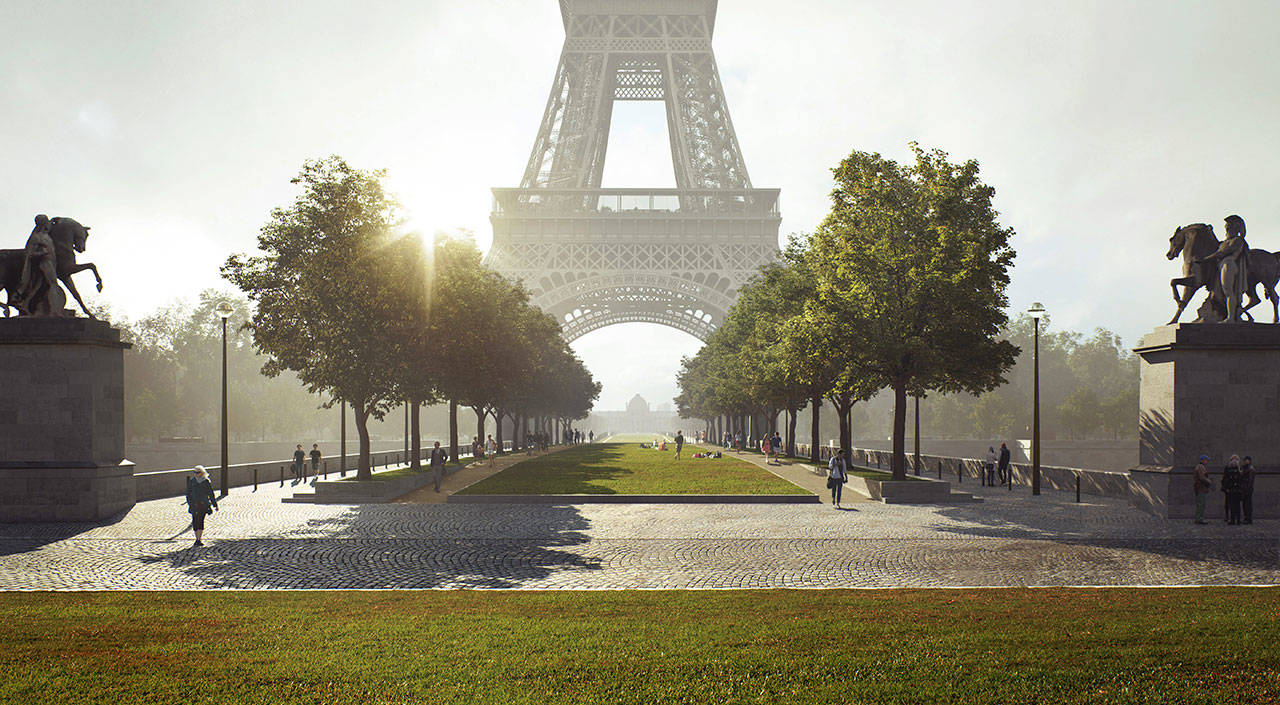Islander and landscape architect Kathryn Gustafson is slated to transform the grounds surrounding the Eiffel Tower, culminating with the opening ceremonies of the 2024 summer Olympic games.
She will speak at Vashon Center for the Arts on Sunday, July 21 at 4 p.m. about revitalizing 130 heavily trafficked acres in the heart of Paris, creating a pedestrian-only park that links monuments and landmarks with a new greenbelt distinguished by lawns, courtyards, a grass amphitheater and cherry blossom trees.
With her office based in London, Gustafson headed the proposal that was later selected by the city of Paris in May, beating out 42 international applicants. The design reorganizes the traffic pattern around the Trocadéro and adds more fountains in the nearby garden. It removes all cars from the Pont D’Iéna Bridge crossing the Seine River and replaces the road with a green promenade accessible only to emergency vehicles.
In a press release, Mayor Anne Hidalgo expressed her enthusiasm about the possibilities.
“I want the Eiffel Tower and its surroundings to become a real place for walking and relaxing, especially on weekends for families, and Paris must be a city where you can let go of your child’s hand,” she said.
Two new squares on either side of the bridge will welcome visitors and stage events while providing for greater access to the tower, accentuated by new plant life and expanded areas designated for luggage. New restaurants and shops will open in the vicinity as access to the Ecole Militaire metro station will be improved, in addition to lighting, security and stormwater management throughout the area.
The total cost of the overhaul is € 72 million, financed entirely by revenue generated from ticket sales made by the Eiffel Tower Operating Company.
The focus of the project is in keeping with the objectives of the 2016 Paris Climate Agreement. In a phone conversation, Gustafson said the design calls for planting more native vegetation and reduces the number of impermeable surfaces, helping to keep the temperature cooler. She added that it also fits squarely into a plan led by the mayor to expunge motor vehicles from the city, prioritizing the creation of bike lanes and pedestrian spaces while easing congestion. Ultimately, she said, that effort will make for a better Paris.
“I just find it really fascinating how a big city actually functions and what it takes to make 15 million people get along,” she said.
Gustafson is no stranger to Paris, or to complex jobs with considerable pressures. She was a member of the landscape design team that took on the National Museum of African American History and Culture in Washington, D.C., integrating the museum into the larger composition of the National Mall. Her team was pivotal in the design of the Diana, Princess of Wales Memorial Fountain in London. More locally, she played a role in the design of the glass backdrops marking The Seattle Civic Center Campus, composed of the Justice Center and Seattle City Hall.
Gustafson studied at the National School of Landscape in France and passed the Eiffel Tower on her way to the metro station every morning. Now she splits her time between the city, where she has lived for 40 years, and her home on Vashon.
The task now before her, Gustafson said, is significant for its scale. But more importantly, fundamentally re-imagining one of the most iconic places in the world will serve as a benchmark of history.
“It’s hugely important within the French psyche, within what it represents to the people, so it’s a very important site,” she said.
Nearly 30 million people visit the Eiffel Tower every year. While few may notice signs of distress or blight, Gustafson said the sheer number of visitors has resulted in overcrowding and impaired accessibility, in addition to compaction of the soil and tree roots, putting a stranglehold on the ecology of the site.
“It really was not built to take the amount of tourism that it gets, so it’s totally run over, ruined. It needs to be renovated seriously,” said Gustafson. “There are some things that need to be changed to be more environmentally conscious, and also much more equity conscious, for all of the different people in the world that come.”
Gustafson said that communication is likely to be one of her greatest challenges. Far more pedestrians currently span the Pont D’Iéna Bridge than vehicles, but closing it off is not a popular idea with everyone. Still, she noted that the main tenets of the project — balancing the demand on each of the spaces and advancing the environmental renewal of the site — have won the admiration of mostly everyone.
“How cities are made, and how we do things for cities to make them more livable, is really important. Even little towns like Vashon, it’s really important that we have a common area; it’s really important that we have common spaces,” she said.
Allison Halstead Reid, Associate Executive Director of Vashon Center for the Arts, said that tickets for Gustafson’s upcoming lecture went on sale last week and some have already sold. Previous events at the arts center with Gustafson have been well attended.
“I am very excited to hear her vision. It’s really incredible that she lives right here on Vashon but has a worldwide impact on the beauty of the world,” she said.
Tickets are $20 General, $18 Members and $15 for students and seniors. They are available for purchase online.



